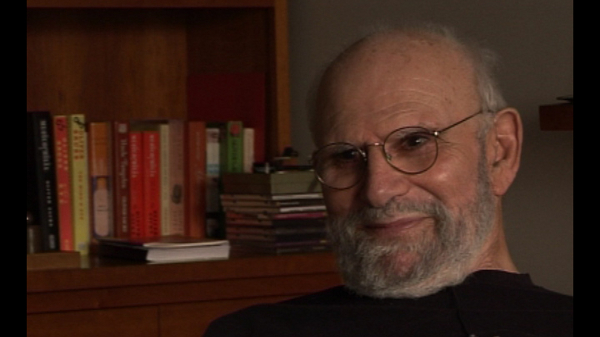NEXT STORY

A Mexican flight like no other
RELATED STORIES

NEXT STORY

A Mexican flight like no other
RELATED STORIES


|
Views | Duration | |
|---|---|---|---|
| 261. Moving from City Island to Manhattan | 779 | 01:17 | |
| 262. Swimming in Lake Titicaca | 324 | 01:43 | |
| 263. Falling in love with Manitoulin Island, Lake Huron | 325 | 02:54 | |
| 264. Writing about my two other main interests: chemistry and museums | 1 | 202 | 05:12 |
| 265. Roald Hoffmann's Chemistry Imagined | 255 | 01:46 | |
| 266. Roald Hoffmann's lecture on the idea of The One... | 257 | 01:11 | |
| 267. Roald Hoffmann sends me a surprise parcel | 199 | 04:09 | |
| 268. Brilliant Light and The American Fern Society | 215 | 03:11 | |
| 269. A Mexican flight like no other | 190 | 01:14 | |
| 270. The Oaxaca Journal | 1 | 233 | 01:59 |


Some of what I’d written was condensed and published under the title of Brilliant Light in The New Yorker. But at that point I couldn’t see my way much beyond an article or perhaps a series of articles, and... and now by one of these strange fertilising cross-currents, I have to bring in something else. One can’t tell a linear history, history isn’t linear. Natural history isn’t linear, personal history isn’t linear, military history isn’t linear. They’re... they're all full of innumerable interacting cross-currents and contingencies.
One of my loves, as I indicated when I spoke of the cycad trees in Guam, one of my loves has been botanical and particularly not flowering plants, which I regard as rather vulgar and trendy sometimes, but more primitive plants like mosses and ferns and cycads and ginkgos. I had become a member of the American Fern Society, which I encountered quite by accident in 1993. I had been wandering around one of the buildings in the [New York] Botanic [sic]Garden with a friend of mine and we blundered into a meeting in progress. And it was very extraordinary. It was like a timewarp. I suddenly felt this was a meeting of the Linnean Society in 1855 or something. There was an extraordinary wonderful old-fashioned quality and enthusiasm about this meeting. Andrew [Wilkes], my friend, said to me, 'These are your people'. And... and he was right. And I became a member of this amateur fern society which had branches all over the States, in fact, has branches all over the world. The fern society would go on forays, on fern forays, perhaps to the wetlands in New Jersey, or... or to some other place where there were unusual ferns. And in 2000, there was a really big foray. We were to go, a number of us, perhaps 20 of us, as a group to Oaxaca in Mexico which has an extraordinary rich fern... an extraordinary rich fern flora. There’s something like 700 species of fern in Oaxaca. And other people from the West Coast and... and the Midwest would be converging, and we would... we would all converge in Oaxaca.
Oliver Sacks (1933-2015) was born in England. Having obtained his medical degree at Oxford University, he moved to the USA. There he worked as a consultant neurologist at Beth Abraham Hospital where in 1966, he encountered a group of survivors of the global sleepy sickness of 1916-1927. Sacks treated these patients with the then-experimental drug L-Dopa producing astounding results which he described in his book Awakenings. Further cases of neurological disorders were described by Sacks with exceptional sympathy in another major book entitled The Man Who Mistook His Wife For A Hat which became an instant best seller on its publication in 1985. His other books drew on his rich experiences as a neurologist gleaned over almost five decades of professional practice. Sacks's work was recognized by prestigious institutions which awarded him numerous honours and prizes. These included the Lewis Thomas Prize given by Rockefeller University, which recognizes the scientist as poet. He was an honorary fellow of both the American Academy of Arts and Letters and the American Academy of Arts and Sciences, and held honorary degrees from many universities, including Oxford, the Karolinska Institute, Georgetown, Bard, Gallaudet, Tufts, and the Catholic University of Peru.
Title: "Brilliant Light" and The American Fern Society
Listeners: Kate Edgar
Kate Edgar, previously Managing Editor at the Summit Books division of Simon and Schuster, began working with Oliver Sacks in 1983. She has served as editor and researcher on all of his books, and has been closely involved with various films and adaptations based on his work. As friend, assistant, and collaborator, she has accompanied Dr Sacks on many adventures around the world, clinical and otherwise.
Tags: Brilliant Light, The New Yorker, Guam, American Fern Society, Linnean Society, New Jersey, Oaxaca, Mexico, New York Botanical Garden
Duration: 3 minutes, 11 seconds
Date story recorded: September 2011
Date story went live: 02 October 2012